Making iPad videos, using VoiceThread, and living a life of non sequiturs
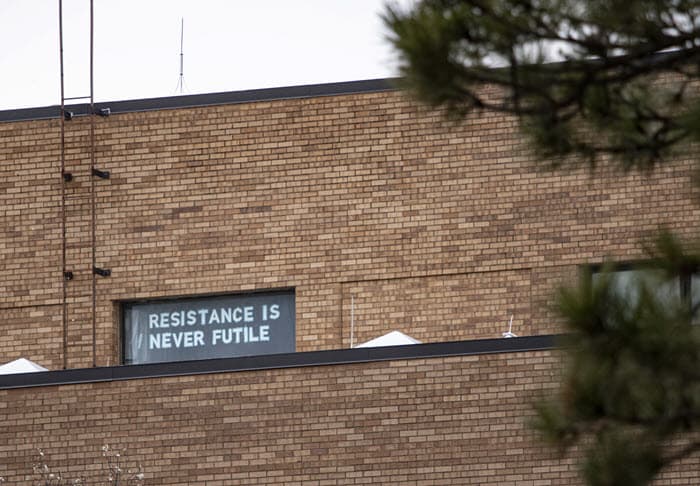
Since the move to remote teaching this semester, several instructors have asked whether it is possible to use their tablets to make videos for students.
The answer is absolutely. I’m most familiar with using an iPad for making videos, but Android tablets work just as well if you have the right app.
Before I explain, I need to provide a caveat. The university’s IT staff doesn’t support the apps I mention here, so if you have to be willing to troubleshoot problems on your own. If you aren’t comfortable with that, use Kaltura, the university-supported video software. The Kaltura desktop software is easy to use and the IT staff can help you with any problems you might encounter.
I like working with a tablet for some types of video because a tablet makes it easy to draw by hand on the screen as you narrate. You can certainly do that with a touchscreen laptop, or with any computer if you are adept at mouse control (I’m not) or you have an input device like a Wacom drawing tablet.
Another benefit of a tablet is its portability. You can create video from almost anywhere. I recommend using a stylus rather than your finger to improve your writing and drawing. I’d also suggest using a headset or headphones with a good microphone. (If you use a USB headset, you will need an adaptor for an iPad.) The built-in microphone on the tablet will work, though.
Two apps for creating video instruction
The two presentation apps I like best are Explain Everything and Vittle. They are powerful tools for creating video presentations you can draw on and narrate. You can import PowerPoint slides and narrate over them, or create presentations within the app with shapes, text, imported media and a laser pointer. You can zoom in and out of the virtual whiteboard, and Vittle allows you to move elements around the whiteboard and capture the motion. Once you are done with a video, you render it as an mp4 file and then upload the file to Kaltura, YouTube or another video hosting platform.
Explain Everything also has collaboration features for classrooms where all students have tablets and access to the app. Vittle is for creation only. Both apps have free versions with limited functionality. I’d recommend downloading those and giving them a test drive. To make the apps fully functional, you will have to pay for them. Explain Everything costs $3 a month. The pro version of Vittle is a one-time cost of $25, although it occasionally goes on sale.
Using VoiceThread for peer editing
Melissa Stamer Peterson, a lecturer in the Applied English Center, has taken a creative approach to peer feedback by using VoiceThread to combine video, audio and student notes.
She starts by loading a short video lecture into VoiceThread. Students then upload their notes and share ideas via VoiceThread, which allows for responses with video, audio or text.
“What was really cool is that they were leaving feedback that I would leave,” Peterson told her colleague Carolyn Heacock in a video conversation that Heacock shared with me.
You can find the full conversation here. VoiceThread has many other examples of how instructors have used the software in classes.
And now for something completely different
That, of course, is the line made famous in Monty Python’s Flying Circus whenever the comedy troupe lapsed into a non sequitur about such things as the Ministry of Silly Walks, dead parrots, a man with three noses, or just the Larch.
The corona virus has turned life into an unending series of non sequiturs. People are stuck inside all day. They can’t go to work. They can’t go to school. They can’t hang out with friends. They are going crazy. I mean CRAZY.
So what do they do? They stack rolls of toilet paper in doorways and have their pets high-jump. It’s called the Level Up Challenge.
I am not making this up.
This should not be confused with the Level Up fitness challenge, which is on hiatus until gyms reopen, or with Ciara’s Level Up dance challenge, which dates to 2018 b.c. (that ancient time before corona) and which led to lunacy even before people were shut in.
This is the new Level Up Challenge, toilet-paper style. It’s hilarious. I’m just not sure where these people get so much toilet paper.
So if you are up for the Level Up Challenge, here are some starter videos.
If you prefer regular human high-jumping (for a world record, no toilet paper involved) …
Or if you prefer something completely different, try Jumping Jack Flash (c. 1968 b.c.)
A place for community during isolation from campus
With apologies to the late Warren Zevon, isolation is hardly splendid – at least when it is forced upon us.
I wrote last week about ways to create structure and belonging for students in online classes. Later in this post, you will find some information about student mental health, which was shaky even before the forced isolation.
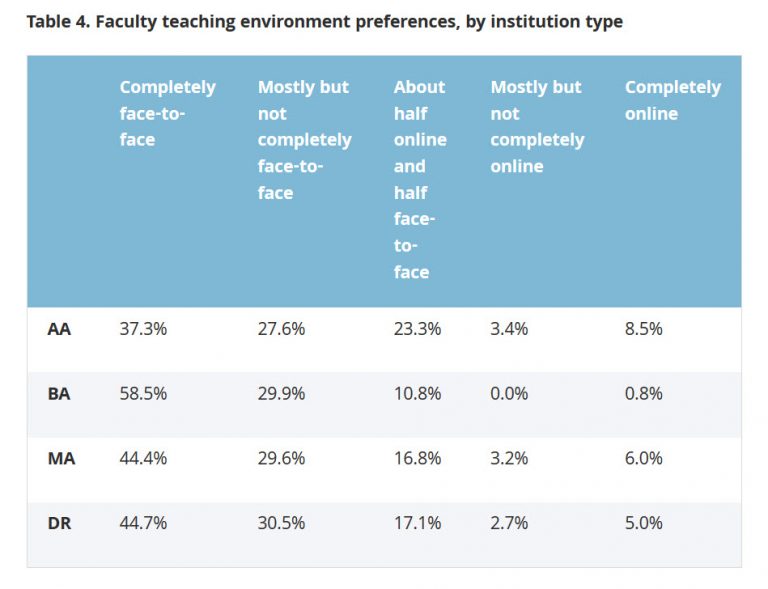
Faculty, too, are feeling the stress, of course. Few of them prefer to teach online, and most have actively avoided it. Now they have no choice, adding to the stress of a pandemic that has roared across the globe, an economy that has screeched to a halt, and a shortage of toilet paper that has – um, let’s not go there.
To help with the challenges of isolation and online teaching, the Center for Teaching Excellence has created a Faculty Consultant Network. This is made up of 13 instructors in 10 disciplines across the university who have experience in online teaching and digital tools. We see the network as an important way for instructors and GTAs to remain connected to the KU community during their time away from campus.
Andrea Greenhoot, the director of CTE, describes the network consultants as peer “thought partners” who can help colleagues in similar disciplines. They are available to meet remotely with colleagues and discuss strategies for teaching and working remotely. They will also help build community among instructors through regular online discussions that anyone can join.
You can find the list of peer consultants on the KU website for remote teaching. You can contact them directly or join their online office hours or open discussions, which are also listed.
An important change in Zoom
Some users of the videoconferencing tool Zoom have reported that outsiders have been able to gain control of meeting screens and display inappropriate material.
To prevent that, the company has changed the default setting on Zoom so that only a meeting organizer has screen-sharing privileges. The organizer can still allow others to display their screens, but the default of allowing anyone to share has changed.
Keeping an eye on mental health
Over the past few days, I have corresponded with students who have talked about being overwhelmed with the volume of communication from their instructors, from the university, from families, and from their children’s schools. Some have been caring for sick relatives in other states. Some are themselves sick. Still others say they are struggling with time management now that the structure of a daily routine has melted away and their children and significant others are stuck inside with them.
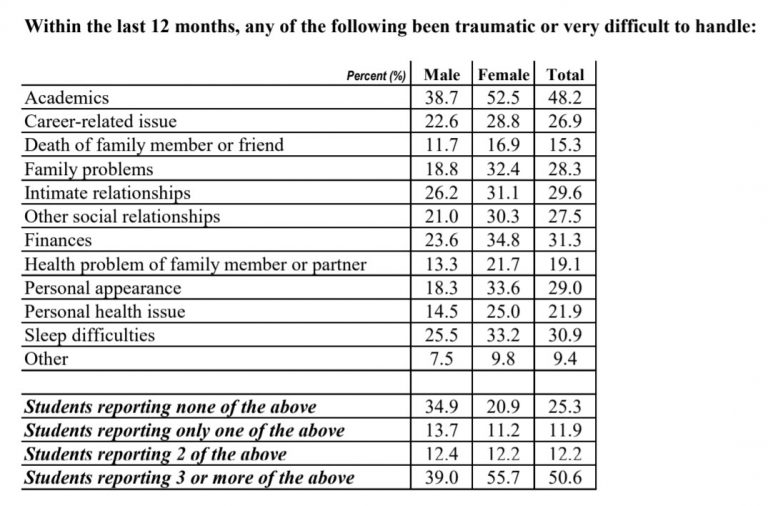
That’s just from a single class of 18. Multiply that by thousands, and you get a sense of the broad, personal impact the pandemic is taking on our students. Consider, too, that even before the current turmoil, student mental health was shaky.
At an online workshop on Monday, Jody Brook, an associate professor of social welfare and a faculty fellow at CTE, offered this statistic for context: More than 60% of college students have had overwhelming levels of anxiety at some point in the previous year. Again, that was before the outbreak of Covid-19.
More than a quarter of students say that anxiety has hurt their academic performance, and 39% of men and 53% of women say that their academic work as been traumatic or difficult to handle in the previous year. These statistics come from the National College Health Assessment.
Brooks and Sydney Morgan, a counselor at Counseling and Psychological Services, said that everyone reacted differently to stress but that instructors needed to watch for these signs among students:
- Students who fail to respond to queries, fail to turn in assignments or suddenly perform worse in class.
- Students who express hopelessness or extreme anger, or who send lengthy rants to others.
- Students who express loneliness, fear or statements about death or suicide in their work.
Don’t be afraid to reach out to students, Brooks and Morgan said, but make sure to refer them to the right resources. CTE also has resources for instructors, and CAPS is also still available. Morgan said CAPS had been transitioning to appointments by phone. If students are out of state, CAPS will help the students find a counselor in their area.
Importantly, instructors need to be flexible and realistic with students. Brooks said that not only was flexibility important but that it was a requirement during a time of crisis. Most students will struggle with maintaining the same level of work they did before the social distancing began. Executive functioning diminishes during times of crisis, making it harder to focus, plan and get things done, Brook said.
That’s worth repeating: Increasing amounts of stress make it hard to focus and get things done. That applies to all of us.
So during this time of less-than-splendid isolation, take a deep breath and forgive yourself for failing to complete even one of the 978 tasks that have suddenly materialized on your to-do list. And consider that your students are facing the same challenges you are, but in different ways.
Helping students find their way through a fog of uncertainty online
The fog that settled on the Lawrence campus Monday morning seemed all too fitting.
Classes officially resumed after an extended spring break, but Jayhawk Boulevard was mostly empty, as were the buses that passed by. Faculty and students alike ventured into a hazy online learning environment cobbled together with unseen computer chips and hidden strings of code. Even the most optimistic took slow, careful steps onto a path with an uncertain end point.
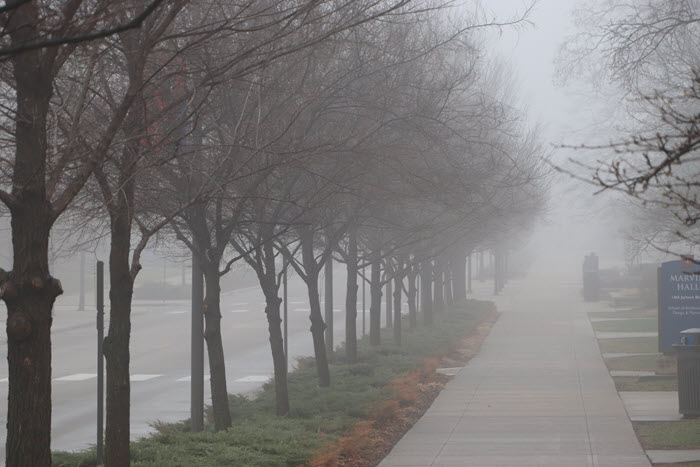
We’re all feeling disoriented in this virtual fog, and it’s especially important for instructors to keep students in mind. Many of them had already been trying to maneuver through the seemingly amorphous landscape of college after relying on a highly structured school routine for much of their lives. Now even the loose structure of campus life has been yanked away.
We can’t change that, but there are some things we can do to help students succeed in the shift to online learning. None of it is difficult, but all of it will be important in helping students adjust.
Create some structure. One reason those of us at the Center for Teaching Excellence, the Center for Online and Distance Learning, and Information Technology have been stressing the use of Blackboard is that it provides a familiar landscape for students. Blackboard’s two biggest strengths are consistency and security. You may not like that consistency — personally, I find it like working within an aging warehouse – but the familiarity of Blackboard can provide a sense of stability for students. They know where to find assignments and they know where to submit their work. Many of them also obsessively check their grades there. Even if you use other online tools, Blackboard can provide a familiar base in the freeform environment of online learning.
Follow a routine. A routine also creates structure for students. For instance, will your class follow a traditional week? Will the week start on Tuesday when you usually had class? Will assignments be due at what would have been class time, or later in the evening? There’s no right answer to any of those questions. The important thing is to follow a routine. Make assignments due on the same days and at the same time each week. Put readings, videos and other course material in the same place each week. Use the Blackboard calendar to list due dates or provide a list of due dates on the start page for your course.
Communicate often. Students are stuck at home just as you are, and they are without the visual and oral cues they rely on from their instructors. That makes it all the more important to communicate. Post announcements on Blackboard. Send email. Set up times when students can call you or reach you through Zoom or Skype. You don’t want to be annoying with constant messages, but you want to make sure students know they can reach you if they need you.

I have found that a weekly message to students can also help create routine. That weekly message reminds students that a new week has begun and that they need to be paying attention to a new set of assignments. I start by providing an overview of the readings, videos and other material students must cover for the week. I also list any assignments due that week and remind students of important due dates coming in the weeks ahead. Then I provide a bit of the unexpected. I share interesting articles, books, podcasts, photos, videos or websites I have found. Sometimes those are related to class material. Other times, they are totally random. My only criterion is that the material is interesting or entertaining.
Ask for their thoughts. More than ever, it is important to seek feedback from students. What is working in the class? What isn’t? Can they find the readings? Do they understand the assignments? Do they have ideas on how to make the class go more smoothly? Everything you are doing in a class may seem clear and logical to you, but students may be lost. So ask them what might help. Create a place on Blackboard for students to submit questions. Create a poll with Qualtrics.
I’ve created a discussion assignment each week on Blackboard where I ask students to share their observations about the switch to online learning. Many of my students are graduate teaching assistants, and I want a place where they can share their experiences with teaching online for the first time but also with how their students are responding to the changes. I’ve never tried anything like this before, so I’m not sure what to expect.
Amy Leyerzapf of the Institute for Leadership Studies has created a “self-care” area on Blackboard for the students in her freshman seminar. This includes a “self-care discussion forum and a collection of carefree bits and pieces, many of them from posts floating around on social media,” she said via email. It also includes links to online cultural sites like streaming opera, museum tours and webcams from zoos and aquariums. There are links to material about mental health resources, at-home exercise and meditation. Importantly, there’s a recipe for peanut butter cookies.
“I’m hoping that it will evolve as students contribute ideas via the discussion forum and I run across more nuggets,” Leyerzapf said.
It seems like a magnificent approach to helping students cut through the haze.
To give your online class a bit of campus feel, add a virtual whistle
It’s the little things we miss when our routines change.

It’s the one on display in the Kansas Union.
As classes move online, those little things will add up for faculty, staff and students. We won’t bump into colleagues along Jayhawk Boulevard. There will be no chalking on sidewalks on Wescoe Beach, no sound of the fountain on West Campus Drive, no view of the Campanile over Potter Lake, no smell of books in the stacks at Watson Library, no view of the flags atop Fraser Hall.
We can build community in our classes and maintain connection with our students and our colleagues. We can’t provide access to all those little things that form a sense of place, though.
There is one little thing I thought might help, though: the sound of the steam whistle.
The whistle, which marks the end of each class period, went silent over spring break, and it hasn’t resumed. After all, there are no classes to signal an end to, no students staring at clocks in lecture halls and waiting to hear the sultry wail of escape echoing across Mount Oread.
And yet, with a pinch of imagination and a dash of digital magic, we can still share the whistle with our students. You will find links to video and audio clips below. They come from a longer video about KU traditions that the university posted in 2011. John Rinnert in IT was able to get a copy for me, and from that I created the snippets you’ll find here.
Feel free to add them to your Blackboard site or share them with your students in other ways. It’s a little thing, but little things matter in times of turmoil.
Creating community in an online course
One aspect of online teaching that I feared would make it less enjoyable for me as an instructor is that my students and I wouldn’t get to know one another as well as we do in our in-person courses.
I thought that it would be difficult to replicate the interaction and dynamic atmosphere of a classroom where we all exchange ideas, participate in thoughtful discussions, challenge each other’s beliefs and positions, develop an understanding of and respect for one another, and come to care about each other as fellow humans.

As I have developed new courses and adjusted and redesigned old courses, though, I have found that creating a real sense of community is possible. To do that, I keep coming back to three general areas. I use them from the start of my online classes, but they apply just as well in a class that is moving online midterm, as we all are doing now.
These are easy to implement, are viewed positively by students, and can even help to reduce the grading burden on the instructor in some instances. Additionally, these techniques do not take away from the time and attention needed for students to interact with the course content in a fast-paced term. In fact, the engagement that results benefits students’ processing of the material as they interact with their classmates.
Establish early contact with students
Reach out to students as soon as possible and encourage them to familiarize themselves with the course components, and establish an expectation that they will be involved in your online class community. It is important that students “hit the ground running” on Day 1 and this early admission into the online course allows them to get ready for what can be a busy and demanding few weeks. It also establishes that you expect them to do a little work up front to be prepared to participate in your course and to interact with you and with their classmates. Here are some examples of how I encourage this early participation and preparation by my students:

- Welcome email: When I turn on the course, I post an announcement and send an email that welcomes students to the course. This email gives them the basic information about how to get started by accessing the course website and where to go from there. I also express my enthusiasm about teaching the course and getting to know them. There is plenty of room for policies and procedures in the course website and syllabus. Use this first contact with students as an opportunity to be friendly and approachable, not to warn them about all the pitfalls of not being prepared or doing the coursework.
- Getting Started section: Once students log into the course website, it is important that they have a detailed roadmap for what you expect them to do before Day 1. Taking the time to build this roadmap for your students will ensure that they are prepared and understand your expectations.
- Welcome video: Making a welcome video seems somewhat unnecessary from a course content perspective but it can go a long way toward students’ seeing you as an approachable, real-life person who wants to engage with your students. This may not be possible in the short time you have to make your class available online this semester, but look for ways like this to remind students that the same person is running the class.
Have an assignment due soon after the course goes online
This assignment is not about the course content. Rather, it is a chance for students to re-introduce themselves to you and to each other. It also helps them become familiar with some of the tools you will use on Blackboard.
Create your own example to share with your students about yourself. Students then get a feel for the people they are interacting with. They can share pictures and learn about families, interests, backgrounds, and jobs. They can see connections between themselves and the life experiences of the people with whom they are enrolled in the course. They can even comment or interact with one another as a way to say hello. Here are two ways that this would be easy to implement and also might allow students practice at using a system or technology that you use later on for actual coursework:

- About Me slide: This version of the assignment asks students to create a slide where they share information and pictures about themselves with you and their fellow classmates. I have used PowerPoint to create my example slide for my courses, but some students simply paste pictures into a Word document. For my example, I include pictures of my family on vacation, pictures of pets, lists of hobbies and interests, and background information about my life. I post my slide as an example with the assignment description. Students can post their slides to a discussion board and then might be required to introduce themselves to another classmate or even find some similarity with a classmate to ensure early interaction.
- VoiceThread introduction: Instead of creating a static slide with pictures and text information, you could use VoiceThread for these early introductions. This method would be especially useful if you plan to use VoiceThread as a course component as it would allow practice with the technology. Students could introduce themselves to one another using their computer webcam. They could show pictures and talk about interests, family, and experiences without it being time-consuming to build. This format also has the potential to increase student involvement. Students might be more likely to watch their classmates’ videos because it is easier than clicking through and reading individual slides for each person
Create smaller communities within your online class
Thus far I have focused on how to set the expectations for engagement early on. Maintaining that feeling of community and requirement for engagement is the focus of this last area.
Many students take online classes because they want to work independently and learn the content in a way that is most efficient and flexible given their life circumstances. However, learning in isolation is not always the best way to fully master and understand the content. Therefore, it is my job as the instructor to build this engagement between students into the course design. I have found that creating smaller communities within an online class can be very effective. Students can get to know a subset of their classmates and participate in assignments and discussions with the same people throughout the semester. This can be accomplished by forming groups or teams of 6-10 students. Assignments that require peer interaction can then be designed to work within this smaller group as opposed to on a class-wide scale. Here are some ways I have used this approach with different assignments in my courses:

- About Me slide. I have students share their About Me slide only with their smaller discussion group and not with the class as a whole. This feels like a more intimate introduction and helps to establish this smaller team from the beginning.
- Written assignments with peer review. We all want our students to practice sharing their thoughts about the course content in written form. However, reading and providing feedback on weekly written assignments can be a very big time commitment for the instructor. Instead, it can be useful to have students peer review each other’s assignments. This system helps to ensure quality without the instructor having to read every assignment every week. Even better, students not only receive very timely feedback on their assignment but they also get to experience what a classmate thought about that week’s topic. This engagement with one another is like having a conversation in class where they can agree or disagree on some topic. Students then can write a reflection that highlights those similarities or differences that they identified. This system can be introduced at the smaller discussion group level, which ensures that students are interacting with the same group of classmates and that those feelings of community can be strengthened and maintained throughout the course.
- Group discussion assignments. Another option for creating engagement with the smaller community is to have weekly discussion topics or prompts that all students must answer within their group. Students must respond to the instructor’s discussion topic(s) by an early due date within that week’s schedule. Group members must then return to the discussion board later in the week to respond to and engage with a classmate about the topic. Again, doing this in a smaller group setting allows for a sense of community, and students get to know one another better than if it is designed to encompass the entire class.
- Afterthoughts assignments. An important goal in my classes is for students to connect the content to their daily lives. I have also used this smaller discussion group setting to get students to make these connections and to decide, as a group, what example might be the best that is presented in a given week among their members. Students are required to post an “afterthought” about the topic(s) we are covering that week on their group discussion board. This post could be a picture or video that illustrates a concept. It could be a link to something they came across on the internet. It could be a text description of something that happened to them. Students must post their “afterthought” to their discussion board and then all group members must return to vote on which one they think is the best example presented that week. They also comment to justify why they voted for a given post. In this way, the smaller group can come together to make a decision about what post might be one that is highlighted by me to the rest of the class.
I feel like I am constantly searching for new ways to engage online students. I want this engagement to benefit their learning and experience in the class and also to make teaching online classes more enjoyable for me. In that search, I have tried many different techniques and some have failed miserably. The ones I have discussed here, however, have stood the test of time and have lived on in various forms, in a variety of courses, and have been useful for different types of content.
When you teach online, nobody laughs at your boots
This is what teaching online looks like.
That’s not quite right. This is what planning for teaching online looks like after a week and a weekend of long days and an early meeting on Monday morning.

About noon, I looked down and realized I was wearing mismatched boots. Some people wear mismatched socks. I wear mismatched boots.
Rather than hide them, I showed them to everyone I met on what was probably the last day of in-person meetings for quite some time. I emailed the photo to colleagues and to my students. Everyone needed the laugh.
“We’re not really laughing at you,” Diana Koslowsky, the administrative officer of the School of Public Affairs and Administration, said after I pulled my feet from beneath a conference table and held them up. “It’s just …”
“We know what it’s like,” said Ward Lyles, an associate professor in the school and a faculty fellow at CTE.
I held up my hands.
“It’s all right,” I said. “Laugh. We all need it.”
Tensions are high right now as the corona virus spreads and instructors scramble to put their courses online. Anxiety lurks on every surface. Encounters with others are awkward as we maintain a distance but still try to be social.
Despite the turmoil, we can’t lose our sense of humor. Laughter is important for maintaining a bond of shared humanity. It’s important for pushing aside the tension, if only briefly.
So laugh at yourself. Laugh at the absurdity of the circumstances. Laugh at Michael Bruening from Missouri University of Science and Technology as he sings “I Will Survive” online teaching. Laugh at my mismatched boots.
I want you to know, though, that even in mismatched boots, I was able to get done everything I needed to get done. My boots may have looked absurd, but I at least put them on the right feet. Mismatched or not, my boots still pointed forward.
Online, nobody knows …
In 1993, The New Yorker published a Peter Steiner cartoon with a caption that said, “On the Internet, nobody knows you’re a dog.”
The cartoon captured the doubts about a growing online culture and the anonymity it represented.
With apologies to Steiner, I offer a remake of the original. I’ll let you decipher it for yourself. I will say, though, that when you teach online, nobody laughs at your boots.
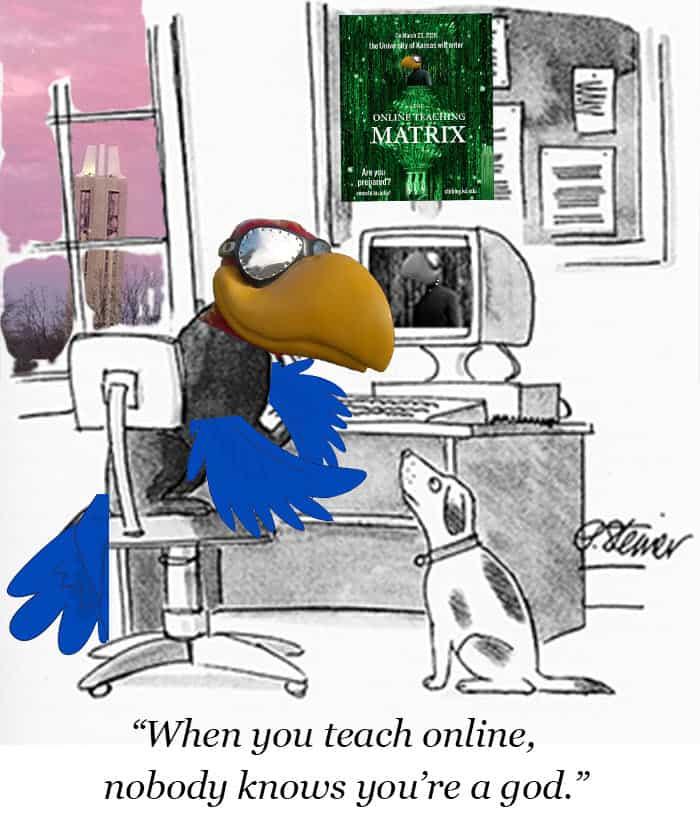
You can complain or you can model. Which will your students see?
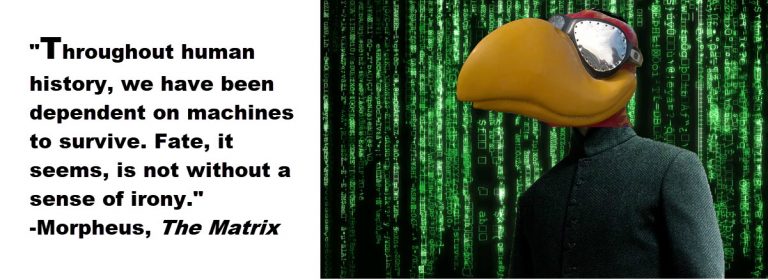
Take a deep breath. You are about to launch into an online adventure.
Yes, I know, you didn’t want to take this trip. The corona virus – and the university – made you do it. Like it or not, though, we are all on the same trip, one that will take us deep into the uncharted territory of a quickly deployed online teaching and learning matrix of enormous scale. This involves not just the University of Kansas, but hundreds of colleges and universities around the world.
Despite the less-than-ideal circumstances, you can still help your students learn online. Despite your wariness of the medium, you can succeed as an online teacher. I’m not trying to be Pollyannaish. (Maybe a little.) Rather, I see this as an opportunity for all of us to break out of ruts we get into in the classroom, examine what we want our students to learn, and consider new ways of accomplishing those goals.
We also have an opportunity to model the types of behavior we want our students to adopt in the face of adversity. They will encounter many challenges in their lives, just as we have, and they are looking to us for guidance not only on college-level learning but on coping with the realities of a global pandemic, economic turmoil, social distancing, and sudden isolation in a world that had been growing more closely connected.
Are you up to the challenge?
Many students don’t think you can do it. . Here’s what one of them had to say last week on Twitter.
“You’re telling me my professor who can’t stop the YouTube autoplayer from playing the next video is going to teach classes online? This should be good.”

That post has been retweeted more than 100,000 times and had drawn nearly 600,000 likes by the weekend. It also attracted a slew of similarly frustrated students who poked fun at their teachers’ technical inadequacies with online grade books, YouTube, web browsers, volume controls, email, and seemingly anything that worked with bits and bytes. (My favorite: The instructor who uses Yahoo to search for Google so he can search for something he wants to show the class.)
“I have no expectations for ANY of my teachers,” one student wrote.
“Pray for the IT department,” wrote another.
Teachers fired back with their own zingers. One wrote:
“You’re telling me my students who can’t pay attention for 2 minutes even while I practically hold their hand through new content are going to have to learn on their own time? This should be good.”
‘We’re all trying really hard’
As the number of zingers grew, though, the tenor of the conversation began to shift. More instructors and instructional designers began to chime in. Many of them had their own doubts about whether this enormous online experiment would work.
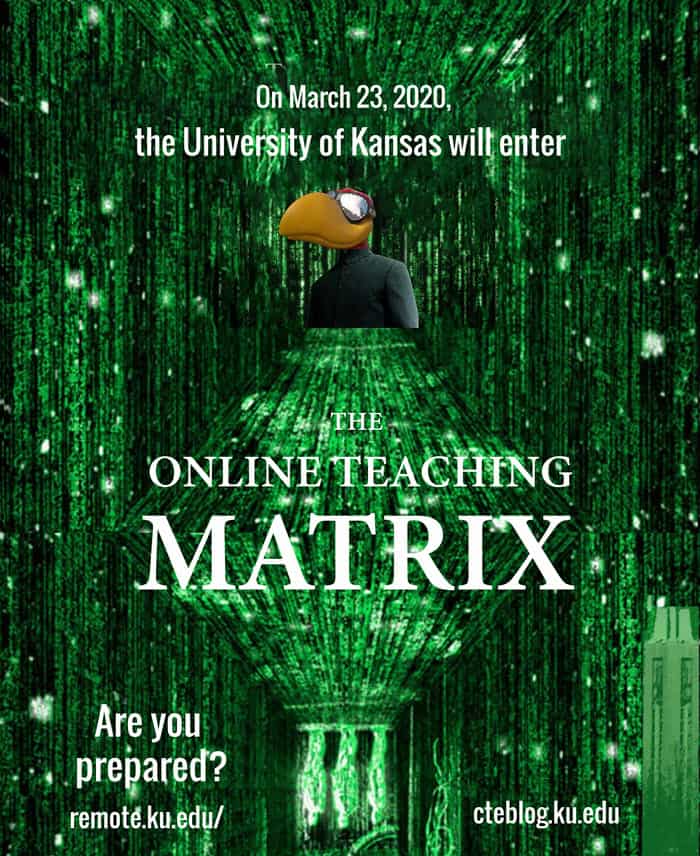
Some talked about the overwhelming task of moving classes online at the last minute. An adjunct who teaches at several schools, each with a different online system, said she was struggling to figure out how to get her classes up and running. Retired professors expressed compassion for their former colleagues, with one saying the reason he retired was that he was no longer up to the technological challenge. Others pleaded for patience.
“We’re all trying really hard,” one instructor said.
Instructional designers wrote about putting in long days to try to make the switch possible. One wrote: “You’re the reason I do this work. I promise I’m doing my best for you.”
A time for compassion
In a single Twitter thread, you see nearly all the directions the next few weeks could take: humor, anxiety, sniping, denial, helplessness, surrender, bitterness, resolve and, yes, even hope.
“Oh, have a heart,” said Jenna Wims Hashway, a law professor at Roger Williams University in Rhode Island. “We’re doing the best we can. I say this as someone who is absolutely certain to screw up this technology that I’ve never used before. But I’m willing to try anything and look like an ass if it means I can teach my students what they need to know.”
No one has all the answers you are looking for as you try to figure out how best to transfer your classroom work online. (There is lots of help available, though.) Students are just as worried as you are about what this will mean for their classes, their learning, their degrees, their graduation, and their lives.
It’s up to you to model what you want to see in your students. If you complain, they will complain. If you show a sense of humor, many of them will still complain. Expect that, and move beyond it.
What you can do
We are taking on what The Chronicle of Higher Education called “the great online-learning experiment” as we are being told to distance ourselves physically from others. That’s intimidating and mentally taxing for instructors and students. Here are some ways you can break through that.
Don’t let the physical distance become mental distance. Campus is strangely silent. The hallways in our buildings are empty. Many of us are working from home. Many of the regular social activities we rely on have been shut down. All of that isolation can take a mental and emotional toll if you let it. So remember to engage with colleagues and your students. Share your feelings. Ask for help when you need it. Join the many workshops we will have on campus and online this week or the many online communities that have popped up to help with online teaching. And take a walk occasionally. Spring is nearly here. Your teaching has become virtual, but you still live in a physical world.
Give yourself a break. One of the challenges of online teaching is that it can feel like class is always in session. You have to set boundaries and establish new routines. Decide when you will engage with class work and when you will do other things. Tell students when you will be available and when you will not. And set aside time for yourself. Don’t let the things that keep you mentally and physically agile slip away.
Work at creating community. This is perhaps the most important thing you can do in any class. Students need to feel that they are part of a learning community. They need your trust and your guidance. They need to know you have a plan – even a tenuous one – to make this work. They need to know that a human being is paying attention beyond the glow of the computer screen. So communicate with students often through whatever means works best for your class. Keep them apprised of your plans. Tell them to expect lots of twists and turns. Tell them that you will be flexible with them and that they should be flexible with you. And remind them not to let the physical distance become mental distance – and to give themselves a break.
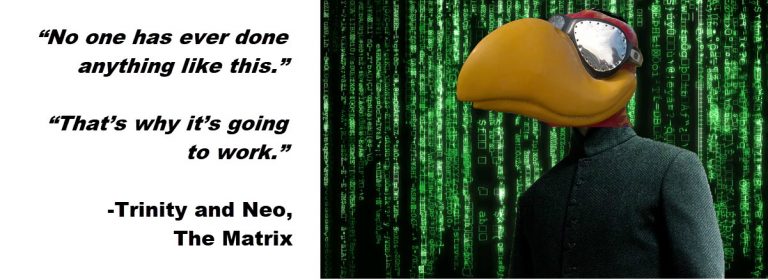
Where to find assistance
Remember, you don’t have to do this alone. There is an abundance of resources available and many people to offer assistance. The best teaching and learning happens as part of a community, and CTE, the Center for Online and Distance Learning, and KU Information Technology are working to bolster that community. We have planned several workshops over the coming week (with more to follow). You’ll find those, along with many other resources to guide you into online teaching, on a new website we created last week.
If you haven’t visited the site, you should. It’s a great place to start if you’ve never taught online before, and it’s a great place to get new ideas if you have. If you need help, the site provides contact information for those of us who can help. We will continue to add material and update the workshops we are planning over the coming weeks. I will also be providing advice through this blog, trying to address myths about online teaching, offer ways to create community in online classes, and suggesting tools you might try to Also let us know what you want to know about online teaching so we can provide the types of materials you and your colleagues need.
Strategic planning and the role of teaching and learning
Distilling hundreds of comments about the future of the university into something manageable and meaningful is, in understated terms, a challenge.
The university’s department of Analytics and Institutional Research accomplished that, though, creating a 73-item list that summarizes ideas from a fall planning session and from comments submitted through an online portal. That list, titled What We Could Do at KU, was distributed to the 150 or so university employees who gathered last week for a second strategic planning session. Presumably, Provost Barbara Bichelmeyer and Chancellor Doug Girod drew on those in creating another document that listed vision, mission and values statements, along with their institutional priorities. The priorities they laid out – student success, healthy and vibrant communities, and research and scholarship – offer a good sense of where they want the university to go in the coming years.
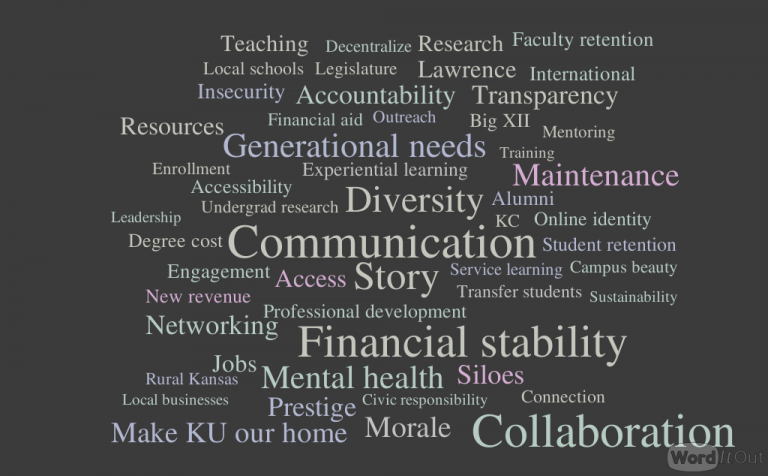
I have a few thoughts about those priorities – namely a lack of any mention of teaching – but I want to focus on something else first.
I found many connections among the 73 suggestions on the What We Could Do list, and I wanted a way to get a better grasp on those ideas. That’s because they provide a broad look at what employees around the university see as important.
I started by creating a spreadsheet, combining and paring the 73 suggestions into 68 words and short phrases. Think of it as a summary of a summary, which has both benefits and drawbacks. I then used those to create the two word clouds that accompany this article.
I wasn’t able to get all 68 words and phrases into a single word cloud, so I eliminated those that were mentioned by fewer than five people. I also created a separate list of 11 verbs that were used in the summary statements. Most describe a need to do more or less of something. This by no means indicates a consensus of ideas from around campus. Rather, it represents the opinions of those who were willing to take the time to attend a planning session or to submit comments online. (I was one of those people.)
Collaborate and communicate
There’s nothing startling on the list, but I was nonetheless surprised by the prominence of collaboration and communication. I agree with those wholeheartedly, and I’m glad others put them at the top of the list.
In far too many cases, departments and offices work in isolation (or in siloes, another word on the list) and even compete against one another for students, resources and attention. To improve as a university, we must find more ways to work together and see ourselves as part of a singular effort rather than as a collection of competing entities. We need to find more ways for our students to collaborate with faculty and with one another. We also need to collaborate with other colleges and universities, and with communities in Lawrence, Kansas City and across Kansas.
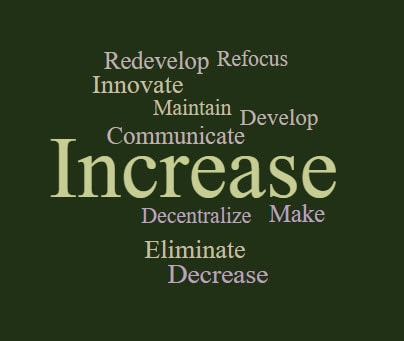
Doing that requires better communication internally and externally. We have to make sure potential partners around the university know what we are doing, and we need to tell our story (another prominent term) to students, families, businesses and communities. They need to understand that we are part of – not separate from – them.
Another frequently mentioned issue, financial stability, ties into other needs like maintenance, retention, accessibility, professional development, degree cost, campus beauty, mental health, morale, accountability and transparency.
Three other prominent terms on the list – diversity, mental health and generational needs – tie closely together. The diversity of the student body has increased over the last decade, but the student population at KU is still predominantly white. The faculty and staff are even less diverse. The current generations of students are more diverse and have different needs from previous generations.
Not surprisingly, most of the comments from around campus called for an increase in something, including diversity, revenue, accountability, prestige, student and faculty retention, and, of course, collaboration and communication. After years of underfunding and a few rounds of budget cuts, there are many unmet needs.
What about teaching?
If the What We Could Do at KU list represented the opinions of faculty and staff, a document called Jawhawks Rising gave a clear sense of where university leaders want to go. It’s a good aspirational document.
Strangely missing, though, is any mention of teaching. The document uses phrasing like “community of learners,” and “student engagement” and “educate leaders.” It lists “student success” as one of three core institutional priorities.
Teaching doesn’t show up anywhere, though. That’s discouraging and disturbing. You can argue that “educate” involves teaching. It does. But without a clear strategy for improving and elevating the importance of teaching, any attempt to improve student success will fall short. And without the involvement of faculty in student success, the vision, the mission and the values of the institution quickly become hollow.
All of this is a work in progress, and encouragingly, Bichelmeyer gave teaching an important nod in remarks she made at the start of the strategic planning session last week.
“We’re learning about how we teach and how our students learn,” Bichelmeyer said, referring to the use of analytics to examine curricula and student movement through curricula. “There are lots of ways where we can start to unpack the individual student from the crowd through watching and knowing that they need a nudge to say, ‘It’s really important for you to get to the first week of class’ or ‘It’s really important that you don’t turn your homework in late.’ ”
She added: “We’re not teaching little widgets on an assembly line where we hold time constant and let achievement vary or we think about our work as production.”
She also pointed to the need to change our approach to engaging students, many of whom work 20 or more hours a week and have family responsibilities. They also see technology as an important part of who they are.
“Students would rather have a lecture on YouTube than sit in a class with a thousand students where they can’t see the professor and they can’t see what’s on the board and they maybe can’t hear,” Bichelmeyer said. “And they don’t have to pay for parking, and they don’t have to get a babysitter, and they can do that at night.
“So when we think about unbundling the elements of instruction, we have to understand that what we do well at the University of Kansas that nobody else can do is we engage students,” she added.
Unbundling and rethinking
Additionally, she said, digital technology is leading to the separation of teaching from certification. That is, students no longer need a university credential to get good jobs. They can learn from many online providers or gain skills from short-term coding camps and other intensive sessions that don’t require a four- or five-year commitment and cost far less than a university degree.
“So we have to think about what it is that only we can do really well and how we think about the educational experience from the students’ perspective in order to help them think about why it’s worth it for them to be at KU,” Bichelmeyer said.
Think collaboration, communication, diversity, generational needs, networking, accessibility, engagement, cost and other terms from the campus list. But also think teaching and learning, which is why students come to the university in the first place.
ed to collaborate with other colleges and universities, and with communities in Lawrence, Kansas City and across Kansas.
As challenges mount, higher ed looks in new directions
WASHINGTON – As colleges and universities prepare to encounter what has become known as a cliff in traditional student enrollment, they are looking for ways to reach out, branch out, and form partnerships that might once have been unthinkable.
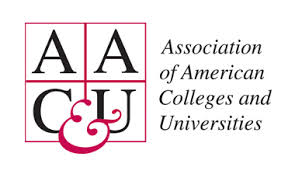 That desire to branch out was clear from the sessions I attended at the annual meeting of the Association of American Colleges and Universities. For instance, speakers at the conference urged colleagues and their universities to:
That desire to branch out was clear from the sessions I attended at the annual meeting of the Association of American Colleges and Universities. For instance, speakers at the conference urged colleagues and their universities to:
- Do a better job of working with community colleges, whose lower cost is appealing to students, most of whom want to continue at four-year institutions.
- Reach out to high school students and introduce them to liberal education before they choose a college and a major.
- Draw in older adults, reintroduce them to learning as they move into a new phase of life, and draw on their expertise in classes and career development.
- Create stronger partnerships with other colleges and universities.
- Create better strategies for telling the story of higher education.
There’s no secret about why branching out is important. At a session titled “Responding to the Crisis in Higher Education,” Elaine Maimon, president of Governors State University in Illinois, said “crisis” had appeared in AAC&U session titles nearly every year in the decades she had been attending the conference. (Maimon was facing her own crisis back home.) Even so, she said:
“I’m ready to say the revolution is here.”
‘Stop rehearsing our dilemmas’
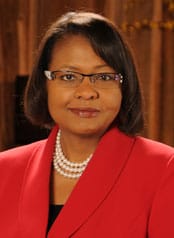
I’ve written considerably about the idea of “revolution” in higher education, about the need for universities to adapt and change, and about the plodding approaches that higher education as a whole has taken to the broad challenges.
In short: The number of traditional students is declining, especially in the Midwest and Northeast. Demographic shifts have created what one AAC&U participant called “a new student majority” made up of first-generation students, students of color, adults, and military veterans, and many of those students start at community colleges. State and federal funding has plummeted. And digital technology has created what Maimon called “an epistemological revolution in terms of ways of knowing.”
Mary Dana Hinton, president of the College of Saint Benedict, said colleges and universities needed to stop “stop rehearsing our dilemmas” and work at making changes.
“We know what our problems are,” Hinton said. “We need to change, and to invest in our faculty, our staff and our leadership so that we create environments and spaces where every student on our campus can see themselves, can feel appreciated, can be challenged and transformed, and that we as institutions are transformed by the students who come to us.”
The sort of transformation that Hinton referred to has many components.
Working with community colleges
Scott Jaschik, editor of Inside Higher Ed, emphasized the importance of making connections with community colleges because “that’s where the students are.”
Most Americans who earn a bachelor’s degree start at community college, Jaschik said, and four-year institutions need to make transfer easier and create welcoming environments for community college students. Some states are also making community college free, he said, an idea that has transcended political ideology.
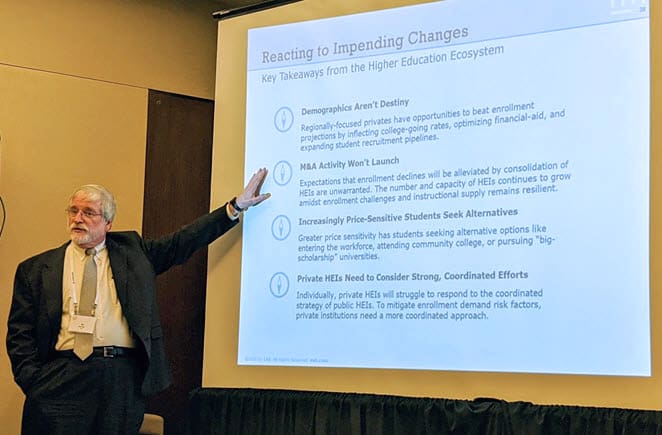
Cost is playing a big part in students’ decisions. Al Newell of the education research company EAB said that the lower cost of community colleges had great appeal to Generation Z, which he described as thrifty and frugal. More than 40% of students whose families earn at least $250,000 a year are considering community colleges, Newell said, with some looking at college as a seven- or eight-year investment if students go to graduate school.
Twenty years ago, he said, students aspired to attend the best school they could get into. Now, he said, students’ mindset is that they will go to the best school that they can get into and that their families can afford.
An announcement last week underscored the importance of community colleges. Southern New Hampshire University, a large provider of online education, offered students of Pennsylvania’s community colleges a 10% tuition discount, a move that is expected to draw students away from the state’s four-year institutions.
A different approach to adult education
A new model for bringing adults into college courses has begun to emerge.
Colleges and universities have offered continuing education classes for adults and retirees for many years. Since the early 2000s, KU and many other universities have been involved in the Osher Lifelong Learning Institute, which focuses on adults age 50 and older. What’s different this time is that universities are creating longer and more intensive programs for older adults, integrating them into traditional classes and activities, and using their expertise to enrich discussions and career preparation.
Longevity is changing workers’ outlook, and many of those in the baby boom generation are looking for new paths after they retire, Kate Schaefers, executive director of the Advanced Careers Initiative at the University of Minnesota, said during an AAC&U panel discussion. Minnesota is one of several universities that have created programs for late-career or retired professionals. Many of those are modeled on Stanford’s Distinguished Careers Institute, which brings in a small cohort each year and helps each participant shape an individual curriculum built on their interests. It integrates them into traditional classes but also creates separate seminars, colloquia and other events. That approach has been successful enough that Stanford is planning to create a non-profit organization to help universities create similar programs, participants at an AAC&U panel said.
Organizers use words like “transformative” to explain the rich opportunities these new programs provide and the powerful bonds they create. The programs are also expensive: often $60,000 a year or more. Most programs offer financial aid for a few fellows, but organizers say the cost reflects the need to be self-sufficient.
Reaching out in other ways
Conference panelists talked about the need to reach out to many other constituencies, including businesses, rural students, low-income students, students of color, non-traditional students, and international students, whose numbers have declined over the past few years.
Colleges and universities start sending promotional material to prospective students early in high school. Later on, they encourage families to tour campuses and to talk with advisors. Those approaches help get a school’s name in students’ mind and help students get a sense of a school’s atmosphere. What they fail to do, though, is to help students understand what happens within a particular discipline.

Andrew Delbanco, president of the Teagle Foundation and a professor at Columbia, said universities needed to create opportunities to bring high school students – especially those from underserved populations – to their campuses for a week or more and engage them in intensive humanities seminars that explore the depth and breadth of liberal education. That approach, which Teagle has been funding, helps students “learn that college is not only about getting a job.” It also helps faculty members, graduate students and undergraduates better understand the perspectives of underserved students.
“We all agree in this room about the value of liberal education,” Delbanco said. “But we have a problem. You cannot explain the value of liberal education to someone who hasn’t had one. You can’t do it. … You cannot convey the taste of honey to someone who hasn’t tasted it.”
The importance of that type of approach was reinforced by statistics at Newell’s session. A survey of 5,200 students at Chicago public schools found that in ninth grade nearly all students aspired to college. By the 11th grade, that dropped to 72%. By 12th grade, 59%. In the end, only 41% enrolled in college.
He cited many reasons for the drop-off: lack of role models who have gone to college; exclusion from advanced placement classes; lack of understanding of the enrollment process; failure to take required courses; and lack of money.
“The reality is that the way we do business is going to have to adapt,” Newell said.
He gave several examples of how colleges and universities were adapting. One of the most prominent is through partnerships with or acquisitions of other institutions. In some cases, university systems are requiring consolidation. In others, a university acquires a nearby struggling institution in what Newell describes as a “goodwill grace merger.” In still others, the acquisitions are pure business deals, or “strategic capital asset acquisition,” as Newell described them. (Think of Purdue’s purchase of Kaplan.)
We also need to keep lobbying skeptical legislators and talking more to a skeptical public, Delbanco said — and working more closely with local communities.
It’s a daunting challenge, but AAC&U sessions seemed far more upbeat than they have been in the past few years, even as Delbanco summed up an admonition that was repeated by several others:
“Colleges and universities must serve young people – and not only young people – beyond their gates more effectively,” he said.
Doug Ward is the associate director of the Center for Teaching Excellence and an associate professor of journalism. You can follow him on Twitter @kuediting.
How a living syllabus can lead to continual improvement in a course
By Doug Ward
The end of a semester is always hectic, but it’s important to spend time reflecting on your classes while things are still fresh in your mind.
Did students learn what you had hoped? If not, what do you need to change the next time you teach the class? What activities or assignments led to unexpected results or fell short of your expectations? What readings did students struggle with and how can you help students grasp them better? What discussion areas resulted in a mostly silent classroom? What elements of your syllabus did students find unclear and need revision?
Those are just a few things to consider. Now is good time to make some notes because by the time you get to a chapter or assignment or module or discussion next time, you will struggle to remember exactly what changes you had planned to make.
Ashley Herda, assistant professor of health, sport and exercise sciences, has found a great way to reflect on her teaching and to make sure she is ready the next time she teaches a class. She calls it a living syllabus.
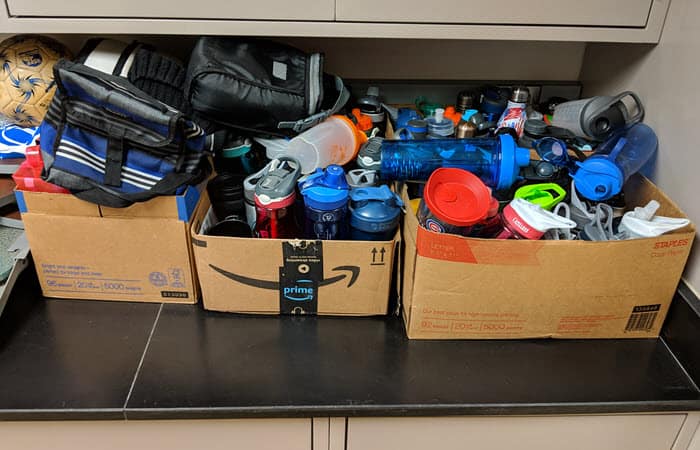
Herda explained her approach during a workshop at the Edwards Campus last week. She said the living syllabus worked like this: After she distributes the course syllabus to students, she sets aside a copy for herself and makes digital notes on it during the semester. If students find something unclear, she makes changes in the syllabus in edit trace immediately. If an assignment takes far less time than she expected, she highlights a section of the syllabus and makes notes in bubbles to the side. If there are problems in grading, she reminds herself right in the document.
This approach makes it easy for her to make adjustments for a future class, she said. Rather than starting from scratch each time, she has the living syllabus ready to go.
I love the idea of a living syllabus. The name perfectly captures the idea of a course in a state of constant improvement. It also turns the syllabus into a means of reflection, not just an artifact of a class.
During the workshop, other instructors explained their own approaches to reflection and course improvement. John Bricklemyer, lecturer in engineering and project management, jots down notes after each module in the online classes he teaches and frequently shares his thoughts with other instructors. Lee Stuart, leadership programs manager on the Edwards Campus, includes a reflection component for each assignment that asks students for their feedback on the assignment. That helps him get a better sense of places where students are struggling or of assignments that might be too easy or that are not meaningful.
Like others, I have long made notes about classes and assignments during the semester. I usually do this in a OneNote file where I keep a class outline, readings and notes. I also build in reflection assignments in each course I teach and ask students to evaluate themselves and the course. When I teach in person, I usually spend part of the last day of class talking with students about the strengths and weaknesses of the class. I’m candid about strong and weak areas I saw in the course and students are generally forthcoming with their own thoughts.
The method of reflection on a course is less important than the act of reflecting, though. The disciplines we study and the courses we teach are dynamic and need continual oversight. Students change. Materials change. Our understanding of the subject matter changes. Needs of a department change.
Imagine how vibrant teaching might be if all instructors embraced the philosophy of a living syllabus. It’s a worthy aspiration.
Guidelines for successful brainstorming
A recent article from Innovation Excellence offered what it called the four rules of brainstorming. The idea of rules for something as freewheeling as brainstorming seems a bit odd, but I can see the logic in establishing some guidelines.
Innovation Excellence attributed the rules to Alex Osborn and his book Applied Imagination, published in 1953. Here they are:
- Go for quantity over quality, because we know the best way to get good ideas is to just start with lots of ideas.
- Withhold criticism, or “no idea is a bad idea.”
- Encourage wild ideas; just freewheel and go crazy? (Sort of the point of rule two.)
- Combine and improve upon ideas.